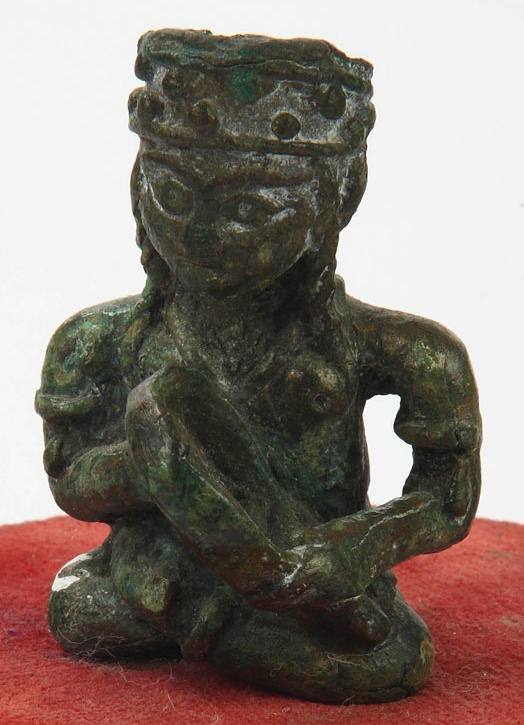
Shop Amazon - Create an Amazon Baby Registry
Fatimid Bronze Figurine of a Woman Playing a Tamborine.



Statuette of female Musician
Title/name : Statuette of female Musician
Discovery place : Fustāt digs, Egypt
Date / period : The eleventh century
Materials and techniques : Cast bronze
Dimensions : Height 5cm, length 3cm
Conservation town : Cairo
Conservation place : The Museum of Islamic Art
Inventory number : 6983
The representation of princely pleasures was a recurrent theme in the Islamic world, from Spain to Iran. Along with dancing, drinking, and hunting, this iconography of worldly pleasures also comprised music. According to historic sources, music was cultivated and encouraged by most of the Fatimid caliphs, and was played on a number of occasions: during military fanfares, after hunting, and during private festivities. As entertainment for high society, these festivities involved the performances of female dancers, singers, and instrumentalists. This little figurine of a musician discovered in the Fustāt dig needs to be seen in the context of this musical culture.
The young woman is sitting in the lotus position, and is wearing two bracelets and a headdress with large studs. Her almond eyes and long hair, falling either side of her face, echo Iranian models, but these features were, in fact, common in Mediterranean representations. She is holding a tambourine, an instrument that existed already in Pharaonic Egypt and was very common in the Middle Ages throughout the Mediterranean world, both in the East[1] and the West[2]. Caliph al-Mustansir (reigned 1036–1094), a great music lover, made a gift of a residence along the Nile (‘the domain of the female tambourine players’) to one of his favourites.
Musicians were represented in many materials: jewels in precious metals[3], lustred ceramics[4], and textiles. The statuette in the Museum of Cairo is one of the rare three-dimensional figures produced in the Islamic world. Other bronze examples were made in Fatimid Egypt, some of which are very small, like this musician. They could be a simple decoration, or have a specific purpose, for example, as the handle on a tap[5] or a grip on a lid. However, like three-dimensional Andalusian sculptures, those produced during the Fatimid era were very often animals. Sometimes human statuettes can be seen in the Iranian world, like the stucco heads in the David Sammling collection, or in the Louvre Museum[6]. Small or large three-dimensional sculptures, in bronze or in stone—a continuation of the classical traditions—were very common in European art.
NOTES
[1] Textile with female tambourine players, thirteenth century (the Kingdom of Granada), silk and gold threads, Cluny Museum, Paris, Cl. 21962 (catalogue of textiles, Cluny, No. 158 p. 296); element of architectural decoration with female tambourine player, thirteenth century (Damascus, Syria), the National Museum, 4/14642 (Saladin p. 48)
[2] Like, for example, the illustrations of a Roman de fauvel, Paris, Vol. 1320, the Bibliothèque nationale de France, Paris, MS. Français 146, fo. 34 and 36 v (Middle Ages, between order and disorder, n69 p. 177)
[3] Musicians’ bracelet, gold, the eleventh to twelfth centuries (Syria?), the Louvre Museum, Paris, MAO 495 (Atlas base)
[4] Dish with rabāb player, twelfth century (Egypt), ceramics with lustre decorations
[5] Fragment of a tap in the shape of a lion surmounted with a peacock, the eleventh century (Egypt or Syria), bronze, the al-Sabah collection, Dar al-Athar al-Isla miyyah, Kuwait, LNS 166 M. (Fatimid treasures of Cairo, No. 47 p. 120)
[6] Stucco heads, twelfth to thirteenth century (Iran), David Sammling, Copenhagen, 44/1978 and 5/1976 and the Louvre Museum, Paris, MAO 1237. (Atlas and catalogue of the David Collection)
Source: qantara
31. Fatimid metal figurine of a woman playing a tamborine or flat drum with a jewel-studded kūfiyya on her head (Museum of Islamic Art, Cairo, no. 6983).
Another ornate cap similar to the ṭāqiyya worn by women as well as men was the kūfiyya. From the descriptions given in the Thousand and One Nights, it was certainly far more ornate than an ordinary cap and seems to correspond more to the kūfiyya worn by women today in Tunisia and Algeria. That is, it was a close fitting cap, often richly embroidered, with flowing ribbons or a scarf hanging down, and studded with semi-precious and even precious stones (see PL 31). Though not frequently mentioned, the kūfiyya already appears in Geniza trousseaux from the late Fatimid and early Ayyubid periods.
Source: Fig. 31, Arab Dress. From the dawn of Islam to Modern times by Smirna Si